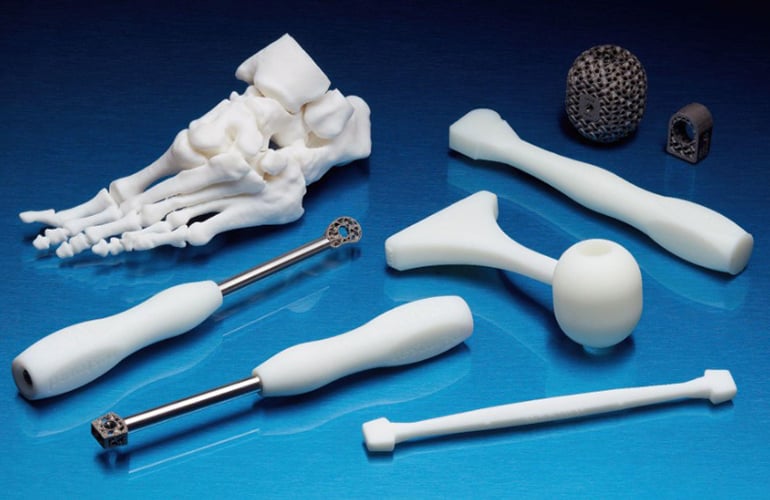
The medical industry has been growing rapidly over the past few years, especially when it comes to technology used to help patients live better lives. One of these technologies that is now making a big impact is 3D printing. While the technology was first developed in 1981, we’ve only seen breakthroughs recently.
Using 3D printing, specialists and technicians can create highly personalized implants and prosthetics, highlighting new opportunities in the field of orthopedic implants. Let’s take a closer look at how 3D printing can be used to create more effective implants for orthopedic patients.
Traditional Orthopedic Implants and Their Limitations
There have been several limitations that surgeons have faced over the years when it comes to orthopedic implants. Let’s say you have to undergo a knee replacement surgery — traditionally, surgeons only had a couple of implant sizes to choose from. They had to look at things like your body height, and more recently, research has even suggested that the surgeon should consider your shoe size.
But, regardless of these factors, there were pre-defined implant sizes that they had to pick from. Usually, your surgeon would do scan and imaging tests to help them determine what kind of implant would work best for you.
The same can be said for shoulder implants. Technology has been improving, but even when surgeons used a 3D planning component, they had an exact match that went as low as 72% in some cases.
How 3D Printing Changes Orthopedic Implants
When 3D printing started to trend a couple of years ago, people used the technology to create all sorts of things. We saw everything from figurines to tools being created with these printers. It soon piqued the interest of medical experts.
Fast forward to today, and we can now use 3D printing to produce a wide variety of medical items. This includes medical devices or even testing products that help doctors in the diagnostics process.
Apart from these, there’s another area where 3D printing is starting to have a big impact – orthopedic implants.
According to one research paper, 3D printing has come to a point where researchers are even able to use the technology in tissue engineering. Something that you have to keep in mind is the fact that 3D printers can be used with a variety of different materials. That’s what makes the technology such an important discovery for the medical industry.
In the past, orthopedic implants were created based on pre-defined standards. However, this has changed with 3D printing, allowing for personalized care.
Now, it’s important that you understand how this process works. When you’re looking for orthopedic surgery abroad, be sure to know what you can expect from 3D printing technology. That way, you’ll be more informed and will also understand the procedure itself better.
The process starts by analyzing your body. That’s what allows the surgeons and technicians involved in the process to custom make an implant that’s personalized and highly accurate.
A combination of imaging technologies can be used to help the technician understand the way they have to design the implant – and yes, every implant is designed for the patient using specialized 3D modeling programs.
The specific type of imaging technology that they’ll use depends on a couple of factors. This includes the area where you need the implant, the complexity of the implant, and the facility that you’re using for the surgery.
Ultrasound, MRI, CT scans, and X-rays are all useful to help guide the technician who will be creating the 3D model of the implant. In most cases, you’ll find that they use a combination of these technologies. This helps to offer a more comprehensive overview of how the implant should be shaped.
Once they have the 3D model, the next step is to feed it onto a 3D printer. At this point, it’s time to select the materials that they will use to print the implant. In most cases, metal is the main material that the technician will use. It’s a strong material that also lasts long.
Metal has been a standard for many types of implants over the years. Even though 3D printers continue to use this material, the benefit here is the fact that the implant is created specifically for you – that means you’ll get a more exact fit.
The final step is the surgical procedure. During this procedure, you’ll be placed under general anesthesia. The surgeon will first remove the damaged tissue from your body, before placing the implant. Note that the procedure still remains invasive, but with a better fit, surgeons may have an easier time ensuring the implant is properly placed.
The greater precision of the fit usually means you’ll have less discomfort compared to using a universal implant. However, your body will still need to go through the entire healing process. So, you can expect pain, but your surgeon will usually prescribe medication to help you deal with these symptoms.
Right now, there’s also a large focus on 3D bioprinting. This type of technology will use tissues from your body to print new parts. According to research papers, 3D bioprinting could even change how orthopedic surgeons can address problems like cartilage deterioration and bone injuries in the future. However, this is something that researchers are still working on. But, given the fact that there is already evidence that shows the potential of the technology, it’s likely going to continue receiving interest going into the future.
Conclusion
With the advancements made in 3D printing technology, it’s now possible to create customized orthopedic implants that can offer better success rates. Even though metal is still largely used in these techniques, the ability to create intriguing designs allows the implants to be a better fit for the patient’s body.






